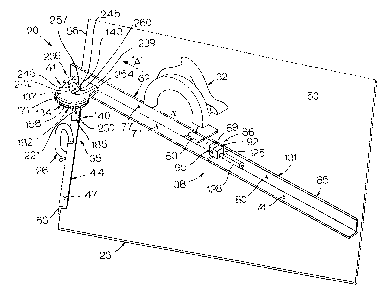Une partie des informations de ce site Web a été fournie par des sources externes. Le gouvernement du Canada n'assume aucune responsabilité concernant la précision, l'actualité ou la fiabilité des informations fournies par les sources externes. Les utilisateurs qui désirent employer cette information devraient consulter directement la source des informations. Le contenu fourni par les sources externes n'est pas assujetti aux exigences sur les langues officielles, la protection des renseignements personnels et l'accessibilité.
L'apparition de différences dans le texte et l'image des Revendications et de l'Abrégé dépend du moment auquel le document est publié. Les textes des Revendications et de l'Abrégé sont affichés :
| (12) Demande de brevet: | (11) CA 2402941 |
|---|---|
| (54) Titre français: | GUIDE DE SCIE |
| (54) Titre anglais: | SAW GUIDE |
| Statut: | Réputée abandonnée et au-delà du délai pour le rétablissement - en attente de la réponse à l’avis de communication rejetée |
| (51) Classification internationale des brevets (CIB): |
|
|---|---|
| (72) Inventeurs : |
|
| (73) Titulaires : |
|
| (71) Demandeurs : |
|
| (74) Agent: | SMART & BIGGAR LP |
| (74) Co-agent: | |
| (45) Délivré: | |
| (22) Date de dépôt: | 2002-09-12 |
| (41) Mise à la disponibilité du public: | 2003-12-04 |
| Licence disponible: | S.O. |
| Cédé au domaine public: | S.O. |
| (25) Langue des documents déposés: | Anglais |
| Traité de coopération en matière de brevets (PCT): | Non |
|---|
| (30) Données de priorité de la demande: | ||||||
|---|---|---|---|---|---|---|
|
A saw guide for guiding hand-held power saws of the type having a moving blade
and a parallel guide edge used far cutting sheet and stock material. The saw
guide
includes a fixed arm of L-shaped cross-section comprising respective
horizontal and
vertical legs. The horizontal leg rests on the upper surface of the material
with the vertical
leg extending downwardly to engage an edge of the material. The fixed leg is
affixed to
the material using a C-clamp which clamps the horizontal leg to the material.
An elongate
variable angle arm also of L-shaped cross-section comprising respective
horizontal and
vertical legs is pivotally connected try the fixed arm by an adjustable angle
locking
assembly. The horizontal leg of the variable angle leg rests on the surface of
the material
with the vertical leg extending upwardly to form an elongate, straight saw
guide surface
for guiding the power saw. The adjustable angle locking assembly pivotally
interconnects
the fixed arm and the variable angle arm for rotation about a common pivot
axis. The
locking assembly is lockable with the fixed arm and the variable angle arm in
a plurality
of angular positions indicated on an angle indicia.
Note : Les revendications sont présentées dans la langue officielle dans laquelle elles ont été soumises.
Note : Les descriptions sont présentées dans la langue officielle dans laquelle elles ont été soumises.

2024-08-01 : Dans le cadre de la transition vers les Brevets de nouvelle génération (BNG), la base de données sur les brevets canadiens (BDBC) contient désormais un Historique d'événement plus détaillé, qui reproduit le Journal des événements de notre nouvelle solution interne.
Veuillez noter que les événements débutant par « Inactive : » se réfèrent à des événements qui ne sont plus utilisés dans notre nouvelle solution interne.
Pour une meilleure compréhension de l'état de la demande ou brevet qui figure sur cette page, la rubrique Mise en garde , et les descriptions de Brevet , Historique d'événement , Taxes périodiques et Historique des paiements devraient être consultées.
| Description | Date |
|---|---|
| Demande non rétablie avant l'échéance | 2008-09-12 |
| Le délai pour l'annulation est expiré | 2008-09-12 |
| Inactive : Abandon.-RE+surtaxe impayées-Corr envoyée | 2007-09-12 |
| Réputée abandonnée - omission de répondre à un avis sur les taxes pour le maintien en état | 2007-09-12 |
| Inactive : CIB de MCD | 2006-03-12 |
| Demande publiée (accessible au public) | 2003-12-04 |
| Inactive : Page couverture publiée | 2003-12-03 |
| Inactive : CIB attribuée | 2002-11-14 |
| Inactive : CIB en 1re position | 2002-11-14 |
| Demande reçue - nationale ordinaire | 2002-10-23 |
| Inactive : Certificat de dépôt - Sans RE (Anglais) | 2002-10-23 |
| Date d'abandonnement | Raison | Date de rétablissement |
|---|---|---|
| 2007-09-12 |
Le dernier paiement a été reçu le 2006-05-01
Avis : Si le paiement en totalité n'a pas été reçu au plus tard à la date indiquée, une taxe supplémentaire peut être imposée, soit une des taxes suivantes :
Les taxes sur les brevets sont ajustées au 1er janvier de chaque année. Les montants ci-dessus sont les montants actuels s'ils sont reçus au plus tard le 31 décembre de l'année en cours.
Veuillez vous référer à la page web des
taxes sur les brevets
de l'OPIC pour voir tous les montants actuels des taxes.
| Type de taxes | Anniversaire | Échéance | Date payée |
|---|---|---|---|
| Taxe pour le dépôt - générale | 2002-09-12 | ||
| TM (demande, 2e anniv.) - générale | 02 | 2004-09-13 | 2004-04-28 |
| TM (demande, 3e anniv.) - générale | 03 | 2005-09-12 | 2005-05-11 |
| TM (demande, 4e anniv.) - générale | 04 | 2006-09-12 | 2006-05-01 |
Les titulaires actuels et antérieures au dossier sont affichés en ordre alphabétique.
| Titulaires actuels au dossier |
|---|
| DIMITRIJE STOJANOVSKI |
| Titulaires antérieures au dossier |
|---|
| S.O. |